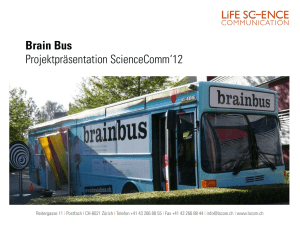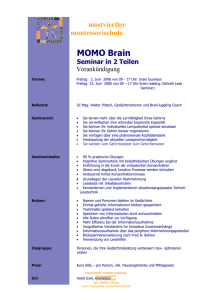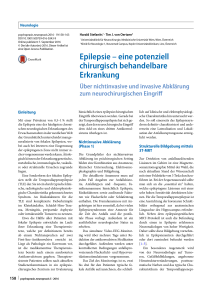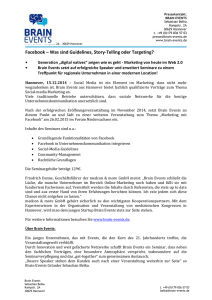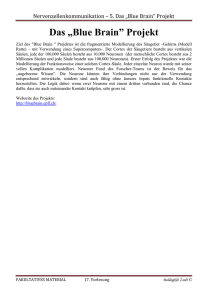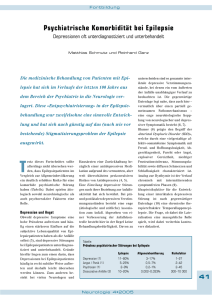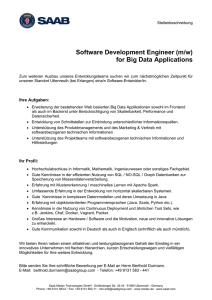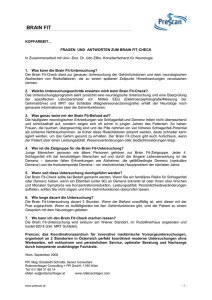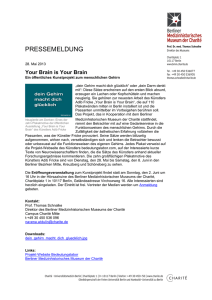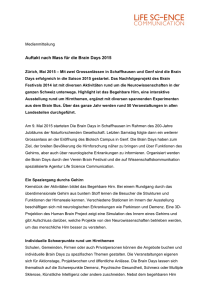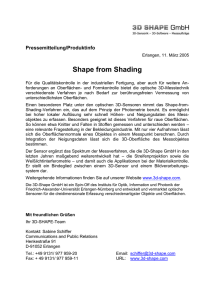Neuropathologisches Institut
Werbung
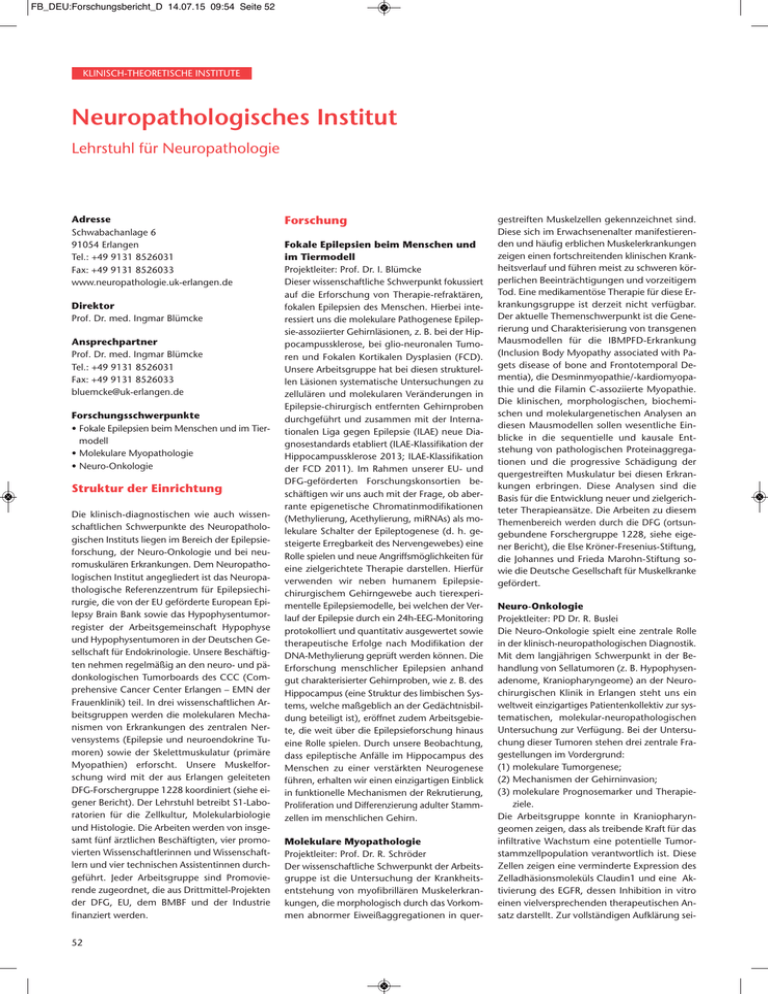
FB_DEU:Forschungsbericht_D 14.07.15 09:54 Seite 52 KLINISCH-THEORETISCHE INSTITUTE Neuropathologisches Institut Lehrstuhl für Neuropathologie Adresse Schwabachanlage 6 91054 Erlangen Tel.: +49 9131 8526031 Fax: +49 9131 8526033 www.neuropathologie.uk-erlangen.de Direktor Prof. Dr. med. Ingmar Blümcke Ansprechpartner Prof. Dr. med. Ingmar Blümcke Tel.: +49 9131 8526031 Fax: +49 9131 8526033 [email protected] Forschungsschwerpunkte • Fokale Epilepsien beim Menschen und im Tiermodell • Molekulare Myopathologie • Neuro-Onkologie Struktur der Einrichtung Die klinisch-diagnostischen wie auch wissenschaftlichen Schwerpunkte des Neuropathologischen Instituts liegen im Bereich der Epilepsieforschung, der Neuro-Onkologie und bei neuromuskulären Erkrankungen. Dem Neuropathologischen Institut angegliedert ist das Neuropathologische Referenzzentrum für Epilepsiechirurgie, die von der EU geförderte European Epilepsy Brain Bank sowie das Hypophysentumorregister der Arbeitsgemeinschaft Hypophyse und Hypophysentumoren in der Deutschen Gesellschaft für Endokrinologie. Unsere Beschäftigten nehmen regelmäßig an den neuro- und pädonkologischen Tumorboards des CCC (Comprehensive Cancer Center Erlangen – EMN der Frauenklinik) teil. In drei wissenschaftlichen Arbeitsgruppen werden die molekularen Mechanismen von Erkrankungen des zentralen Nervensystems (Epilepsie und neuroendokrine Tumoren) sowie der Skelettmuskulatur (primäre Myopathien) erforscht. Unsere Muskelforschung wird mit der aus Erlangen geleiteten DFG-Forschergruppe 1228 koordiniert (siehe eigener Bericht). Der Lehrstuhl betreibt S1-Laboratorien für die Zellkultur, Molekularbiologie und Histologie. Die Arbeiten werden von insgesamt fünf ärztlichen Beschäftigten, vier promovierten Wissenschaftlerinnen und Wissenschaftlern und vier technischen Assistentinnen durchgeführt. Jeder Arbeitsgruppe sind Promovierende zugeordnet, die aus Drittmittel-Projekten der DFG, EU, dem BMBF und der Industrie finanziert werden. 52 Forschung Fokale Epilepsien beim Menschen und im Tiermodell Projektleiter: Prof. Dr. I. Blümcke Dieser wissenschaftliche Schwerpunkt fokussiert auf die Erforschung von Therapie-refraktären, fokalen Epilepsien des Menschen. Hierbei interessiert uns die molekulare Pathogenese Epilepsie-assoziierter Gehirnläsionen, z. B. bei der Hippocampussklerose, bei glio-neuronalen Tumoren und Fokalen Kortikalen Dysplasien (FCD). Unsere Arbeitsgruppe hat bei diesen strukturellen Läsionen systematische Untersuchungen zu zellulären und molekularen Veränderungen in Epilepsie-chirurgisch entfernten Gehirnproben durchgeführt und zusammen mit der Internationalen Liga gegen Epilepsie (ILAE) neue Diagnosestandards etabliert (ILAE-Klassifikation der Hippocampussklerose 2013; ILAE-Klassifikation der FCD 2011). Im Rahmen unserer EU- und DFG-geförderten Forschungskonsortien beschäftigen wir uns auch mit der Frage, ob aberrante epigenetische Chromatinmodifikationen (Methylierung, Acethylierung, miRNAs) als molekulare Schalter der Epileptogenese (d. h. gesteigerte Erregbarkeit des Nervengewebes) eine Rolle spielen und neue Angriffsmöglichkeiten für eine zielgerichtete Therapie darstellen. Hierfür verwenden wir neben humanem Epilepsiechirurgischem Gehirngewebe auch tierexperimentelle Epilepsiemodelle, bei welchen der Verlauf der Epilepsie durch ein 24h-EEG-Monitoring protokolliert und quantitativ ausgewertet sowie therapeutische Erfolge nach Modifikation der DNA-Methylierung geprüft werden können. Die Erforschung menschlicher Epilepsien anhand gut charakterisierter Gehirnproben, wie z. B. des Hippocampus (eine Struktur des limbischen Systems, welche maßgeblich an der Gedächtnisbildung beteiligt ist), eröffnet zudem Arbeitsgebiete, die weit über die Epilepsieforschung hinaus eine Rolle spielen. Durch unsere Beobachtung, dass epileptische Anfälle im Hippocampus des Menschen zu einer verstärkten Neurogenese führen, erhalten wir einen einzigartigen Einblick in funktionelle Mechanismen der Rekrutierung, Proliferation und Differenzierung adulter Stammzellen im menschlichen Gehirn. Molekulare Myopathologie Projektleiter: Prof. Dr. R. Schröder Der wissenschaftliche Schwerpunkt der Arbeitsgruppe ist die Untersuchung der Krankheitsentstehung von myofibrillären Muskelerkrankungen, die morphologisch durch das Vorkommen abnormer Eiweißaggregationen in quer- gestreiften Muskelzellen gekennzeichnet sind. Diese sich im Erwachsenenalter manifestierenden und häufig erblichen Muskelerkrankungen zeigen einen fortschreitenden klinischen Krankheitsverlauf und führen meist zu schweren körperlichen Beeinträchtigungen und vorzeitigem Tod. Eine medikamentöse Therapie für diese Erkrankungsgruppe ist derzeit nicht verfügbar. Der aktuelle Themenschwerpunkt ist die Generierung und Charakterisierung von transgenen Mausmodellen für die IBMPFD-Erkrankung (Inclusion Body Myopathy associated with Pagets disease of bone and Frontotemporal Dementia), die Desminmyopathie/-kardiomyopathie und die Filamin C-assoziierte Myopathie. Die klinischen, morphologischen, biochemischen und molekulargenetischen Analysen an diesen Mausmodellen sollen wesentliche Einblicke in die sequentielle und kausale Entstehung von pathologischen Proteinaggregationen und die progressive Schädigung der quergestreiften Muskulatur bei diesen Erkrankungen erbringen. Diese Analysen sind die Basis für die Entwicklung neuer und zielgerichteter Therapieansätze. Die Arbeiten zu diesem Themenbereich werden durch die DFG (ortsungebundene Forschergruppe 1228, siehe eigener Bericht), die Else Kröner-Fresenius-Stiftung, die Johannes und Frieda Marohn-Stiftung sowie die Deutsche Gesellschaft für Muskelkranke gefördert. Neuro-Onkologie Projektleiter: PD Dr. R. Buslei Die Neuro-Onkologie spielt eine zentrale Rolle in der klinisch-neuropathologischen Diagnostik. Mit dem langjährigen Schwerpunkt in der Behandlung von Sellatumoren (z. B. Hypophysenadenome, Kraniopharyngeome) an der Neurochirurgischen Klinik in Erlangen steht uns ein weltweit einzigartiges Patientenkollektiv zur systematischen, molekular-neuropathologischen Untersuchung zur Verfügung. Bei der Untersuchung dieser Tumoren stehen drei zentrale Fragestellungen im Vordergrund: (1) molekulare Tumorgenese; (2) Mechanismen der Gehirninvasion; (3) molekulare Prognosemarker und Therapieziele. Die Arbeitsgruppe konnte in Kraniopharyngeomen zeigen, dass als treibende Kraft für das infiltrative Wachstum eine potentielle Tumorstammzellpopulation verantwortlich ist. Diese Zellen zeigen eine verminderte Expression des Zelladhäsionsmoleküls Claudin1 und eine Aktivierung des EGFR, dessen Inhibition in vitro einen vielversprechenden therapeutischen Ansatz darstellt. Zur vollständigen Aufklärung sei- FB_DEU:Forschungsbericht_D 14.07.15 10:03 Seite 53 ner Wirksamkeit ist ein Tiermodell von entscheidender Bedeutung. In den beiden letzten Jahren ist es der Arbeitsgruppe gelungen, ein Protokoll zur Herstellung eines intrakraniellen humanen Kraniopharyngeom-Tiermodells (Xenotransplantationsmodell) zu entwickeln. Neben der Validierung neuer zielgerichteter molekularer Therapiestrategien ermöglicht dieses Modell außerdem bereits etablierte Behandlungsansätze (z. B. Radiotherapie) weiterzuentwickeln und Mechanismen der Rezidivbildung zu entschlüsseln. Die Arbeiten unserer Arbeitsgruppe werden durch die DFG, Dr. Robert-Pfleger-Stiftung, Dr. Ernst und Anita Bauer Stiftung und die Internationale Stiftung Neurobionik unterstützt. Ausgewählte Publikationen Blümcke I et al. International consensus classification of hippocampal sclerosis in temporal lobe epilepsy: a Task Force report from the ILAE Commission on Diagnostic Methods. Epilepsia 2013, 54(7): 1315-29 Kreutzfeldt M, Bergthaler A, Fernandez M, Brück W, Steinbach K, Vorm M, Coras R, Blümcke I, Bonilla WV, Fleige A, Forman R, Müller W, Becher B, Misgeld T, Kerschensteiner M, Pinschewer DD, Merkler D. Neuroprotective intervention by interferon-γ blockade prevents CD8+ T cell-mediated dendrite and synapse loss. J Exp Med 2013, 210(10): 2087-103 Kobow K, Kaspi A, Harikrishnan KN, Kiese K, Ziemann M, Khurana I, Fritzsche I, Hauke J, Hahnen E, Coras R, Mühlebner A, El-Osta A, Blümcke I. Deep sequencing reveals increased DNA methylation in chronic rat epilepsy. Acta Neuropathol 2013, 126(5): 741-56 Coras R, Pauli E, Li J, Schwarz M, Rössler K, Buchfelder M, Hamer H, Stefan H, Blumcke I. Differential influence of hippocampal subfields to memory formation: insights from patients with temporal lobe epilepsy. Brain 2014, 137(7): 1945-57 Stache C, Hölsken A, Fahlbusch R, Flitsch J, Schlaffer SM, Buchfelder M, Buslei R. Tight junction protein claudin-1 is differentially expressed in craniopharyngioma subtypes and indicates invasive tumor growth. Neuro Oncol 2014, 16(2): 256-64 Winter L, Staszewska I, Mihailovska E, Fischer I, Goldmann WH, Schröder R, Wiche G. Chemical chaperone ameliorates pathological protein aggregation in plectin-deficient muscle. J Clin Invest 2014, 124(3): 1144-57 Kraniopharyngeom Xenotransplantationsmodell Drei Monate nach Transplantation des Tumorgewebes konnten mit Hilfe einer 4,7 Tesla MR Bildgebung subdural lokalisierte Läsionen nachgewiesen werden. Die T1-gewichteten Sequenzen ermöglichten eine dreidimensionale Rekonstruktion des Xenotransplantates, die die Ausbildung von fingerförmigen Tumorausläufern ins umliegende Gehirngewebe in vivo dokumentieren (A). Nach histologischer Aufarbeitung des gleichen Xenotransplantates bestätigten Hämatoxylin Eosin Färbungen das infiltrative Wachstumsmuster des Tumors (B). (Aus: Stache C et al. Brain Pathool 2015. Mit freundlicher Genehmigung des Verlages Wiley Company.) Lehre Das Neuropathologische Institut beteiligt sich an der Hauptvorlesung Pathologie im fünften Semester, den histopathologischen Kursen im sechsten Semester, klinisch-pathologischen Fallkonferenzen im neunten Semester, dem Repetitorium als Vorbereitung auf den Zweiten Abschnitt der Ärztlichen Prüfung und an der Vertiefungsvorlesung Pathologie für Molekular-Mediziner im fünften Semester. Zudem bieten wir das Wahlfach „Klinische Neuropathologie” an. Es besteht ganzjährig die Möglichkeit zur Hospitation in der klinischen Diagnostik sowie für wissenschaftliche Ausbildungen im Rahmen von F1/F2/F3-Praktika im Studiengang „Molekulare Medizin” als auch die Betreuung von Bachelorund Masterarbeiten. Internationale Zusammenarbeit Prof. J. Engel Jr., David Geffen School of Medicine at UCLA, Los Angeles: USA Prof. A. El-Osta, Monash University, Melbourne: Australia Prof. G. Wiche, University of Vienna, Vienna: Austria Prof. F. Cendes, University of Campinas, Campinas: Brazil Dr. U. Bartels, Department of Paediatrics, SickKids – Hospital, Toronto: Canada Dr. J.P. Martinez-Barbera, UCL, London: UK Prof. A. Pitkänen, University of Eastern Finland, Kupio: Finland Dr. R. Spreafico, IRCCS Foundation Neurological Institute „Carlo Besta“, Milano: Italy Kongresse und überregionale Fortbildungen 16. – 20.09.2013: 1st International Summer School for Neuropathology and Epilepsy Surgery (INES 2013), Erlangen 10. – 13.06.2014 Molecular insight into muscle function and protein aggregate myopathies. Special Interest Meeting of the German Society for Cell Biology (DGZ), Potsdam 30.08. – 03.09.2014: 2nd International Summer School for Neuropathology and Epilepsy Surgery (INES 2014), Erlangen 53 FB_ENG:Forschungsbericht_ENG 17.07.15 11:08 Seite 52 CLINICAL THEORETICAL INSTITUTES Institute of Neuropathology Chair of Neuropathology Address Schwabachanlage 6 91054 Erlangen Phone: +49 9131 8526031 Fax: +49 9131 8526033 www.neuropathologie.uk-erlangen.de Director Prof. Dr. med. Ingmar Blümcke Contact Prof. Dr. med. Ingmar Blümcke Phone: +49 9131 8526031 Fax: +49 9131 8526033 [email protected] Research Focus • Focal human epilepsies and animal models • Molecular myopathology • Neuro-oncology Structure of the Institute Our academic staff and technicians are engaged in studies addressing molecular pathomechanisms of CNS (epilepsy and neuro-oncology) and skeletal muscle disorders. We have established the neuropathological reference center for epilepsy surgery, the European Epilepsy Brain Bank (supported by EU funding) and pathology register for sellar tumors (working group “Hypophyse und Hypophysentumoren” of the German Society for Endocrinology). Five physicians cover all diagnostic issues in surgical neuropathology and neuro-oncology in adults and children. Our laboratories are equipped for histology, cell biology, molecular diagnostics and the Institute of Neuropathology hosts the DFG research unit 1228 addressing pathogenic mechanisms of myofibrillar myopathies (see own report). Research Focal human epilepsies and animal models Project manager: Prof. Dr. I. Blümcke Our working group addresses drug-resistant focal epilepsies in humans to decipher molecular pathomechanisms in brain lesions associated with chronic seizures, e.g. hippocampal sclerosis, glio-neuronal tumors, and focal cortical dysplasias. We perform systematic analysis in surgically resected human brain specimens in correlation to clinical histories and postsurgical follow-up data, and our work contributed in establishing new international standards for clinicopathological diagnosis of Focal Cortical Dyspla52 sias (ILAE classification 2011) and Hippocampal Sclerosis (ILAE classification 2013). Our group also addresses molecular pathomechanisms of epileptogenesis. We study epigenetic chromatin modifications in human surgical specimens and use an experimental animal model with 24h video-EEG monitoring to quantitatively examine seizure burden in animals. In this model, we also tested new therapeutic approaches modifying DNA methylation by a ketogenic diet regimen. Research of human epilepsies and histopathologically well-characterized surgical specimens obtained from patients with temporal lobe epilepsy opens new avenues to also study higher brain function in humans, as the hippocampus plays a major role in memory formation and recall. In addition, our finding of epilepsy-induced neurogenesis in the human hippocampus offers the possibility to unravel molecular signals for the recruitment, proliferation, and differentiation of adult stem cells in the human brain. Molecular myopathology Project manager: Prof. Dr. R. Schröder The central research topic of this group is the pathogenesis of myofibrillar myopathies which are morphologically characterized by the presence of pathological protein aggregation in cross-striated muscle cells. These adult onset and often heritable myopathies are clinically characterized by a progressive course leading to severe disability and premature death. To date, no drug treatment is available for these disorders. The main focus of our current research work is the generation and characterization of transgenic mouse models for the IBMPFD disease (Inclusion Body Myopathy associated with Pagets disease of bone and Frontotemporal Dementia), the desmin myopathy and cardiomyopathy, and the filamin C-associated myopathy. The clinical, morphological, biochemical, and molecular analysis of these mouse models shall provide deeper insights into the molecular ”sequence” that leads to pathological protein aggregation and progressive muscle damage in these disorders. This work will be the basis for novel targeted treatment strategies. Our research is currently funded by the DFG (research unit FOR 1228, see own report), the Else-Kröner-Fresenius Foundation, the Johannes und Frieda Marohn-Foundation, and the Deutsche Gesellschaft für Muskelkranke. Neuro-oncology Project manager: PD Dr. R. Buslei The field of neurooncology plays an important role within the clinical-neuropathological diag- nostics. Due to the longstanding focus of the Department of Neurosurgery in Erlangen on the treatment of tumors of the sellar region (e.g. pituitary adenomas, craniopharyngiomas), a unique collection of surgical tissue samples is available for systematic molecular-neuropathological analyses. Our research comprises three major topics: (1) Molecular tumorigenesis; (2) Pathomechanisms of brain invasion; (3) Molecular prognostic markers and treatment targets. Concerning craniopharyngiomas, our group identified a potential tumor stem cell population which is held responsible to be the driving force of infiltrating growth of tumor cells into the brain. This specific cell population shows simultaneously a diminished expression of the cell adhesion molecule Claudin-1 and an activation of the EGFR. The latter can be targeted by inhibitors what displays a promising therapeutic approach according to in vitro testing. To clarify the underlying mechanisms in detail, an in vivo model for human craniopharyngioma is of crucial importance. During the last two years our group established a protocol for the generation of an intracranial xenotransplant animal model for human craniopharyngiomas. This model allows not only for the validation of innovative targeted treatment protocols, but also for the refinement of established therapy schedules (e.g. radiotherapy). Moreover, the xenotransplant model enables to further investigate the mechanisms leading to tumor recurrence. Our work is supported by DFG, Dr. Robert-PflegerFoundation, Dr. Ernst and Anita Bauer Foundation, and the International Foundation Neurobionik. Craniopharyngioma xenotransplantation model Three months after tumor transplantation, 4.7 Tesla magnetic resonance imaging revealed subdural located lesions. T1-weighted sequences enabled 3D-reconstruction of xenotransplants to study the development of finger-shaped tumor protrusions into subjacent brain tissue (A). Hematoxylin and eosin staining of corresponding histologically processed xenotransplant confirms infiltrative growth pattern (B). (From: Stache C et al. Brain Pathool 2015. With kind permission of the publisher Wiley Company.) FB_ENG:Forschungsbericht_ENG 17.07.15 11:08 Seite 53 Teaching Our Institute is enrolled in pathology training and lectures. Selected Publications Blümcke I et al. International consensus classification of hippocampal sclerosis in temporal lobe epilepsy: a Task Force report from the ILAE Commission on Diagnostic Methods. Epilepsia 2013, 54(7): 1315-29 Kreutzfeldt M, Bergthaler A, Fernandez M, Brück W, Steinbach K, Vorm M, Coras R, Blümcke I, Bonilla WV, Fleige A, Forman R, Müller W, Becher B, Misgeld T, Kerschensteiner M, Pinschewer DD, Merkler D. Neuroprotective intervention by interferon-γ blockade prevents CD8+ T cell-mediated dendrite and synapse loss. J Exp Med 2013, 210(10): 2087-103 Kobow K, Kaspi A, Harikrishnan KN, Kiese K, Ziemann M, Khurana I, Fritzsche I, Hauke J, Hahnen E, Coras R, Mühlebner A, El-Osta A, Blümcke I. Deep sequencing reveals increased DNA methylation in chronic rat epilepsy. Acta Neuropathol 2013, 126(5): 741-56 Coras R, Pauli E, Li J, Schwarz M, Rössler K, Buchfelder M, Hamer H, Stefan H, Blumcke I. Differential influence of hippocampal subfields to memory formation: insights from patients with temporal lobe epilepsy. Brain 2014, 137(7): 1945-57 Stache C, Hölsken A, Fahlbusch R, Flitsch J, Schlaffer SM, Buchfelder M, Buslei R. Tight junction protein claudin-1 is differentially expressed in craniopharyngioma subtypes and indicates invasive tumor growth. Neuro Oncol 2014, 16(2): 256-64 Winter L, Staszewska I, Mihailovska E, Fischer I, Goldmann WH, Schröder R, Wiche G. Chemical chaperone ameliorates pathological protein aggregation in plectin-deficient muscle. J Clin Invest 2014, 124(3): 1144-57 International Cooperations Prof. J. Engel Jr., David Geffen School of Medicine at UCLA, Los Angeles: USA Prof. A. El-Osta, Monash University, Melbourne: Australia Prof. G. Wiche, University of Vienna, Vienna: Austria Prof. F. Cendes, University of Campinas, Campinas: Brazil Dr. U. Bartels, Department of Paediatrics, SickKids – Hospital, Toronto: Canada Dr. J.P. Martinez-Barbera, UCL, London: UK Prof. A. Pitkänen, University of Eastern Finland, Kupio: Finland Dr. R. Spreafico, IRCCS Foundation Neurological Institute ”Carlo Besta“, Milano: Italy Meetings and International Training Courses 16. – 20.09.2013: 1st International Summer School for Neuropathology and Epilepsy Surgery (INES 2013), Erlangen 10. – 13.06.2014 Molecular insight into muscle function and protein aggregate myopathies. Special Interest Meeting of the German Society for Cell Biology (DGZ), Potsdam 30.08. – 03.09.2014: 2nd International Summer School for Neuropathology and Epilepsy Surgery (INES 2014), Erlangen 53
